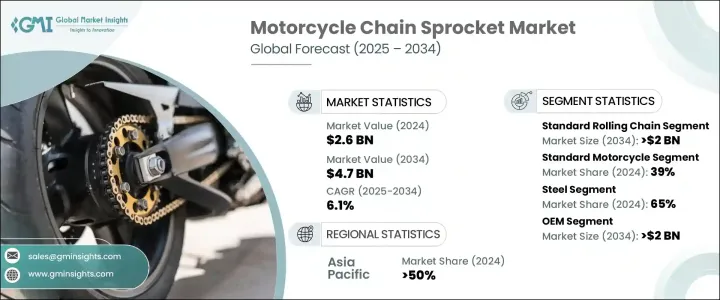
세계의 오토바이용 체인 스프로킷 시장 규모는 2024년 26억 달러로 평가되었고, 2034년에는 47억 달러에 이를 것으로 예측되며, CAGR 6.1%로 성장할 전망입니다. 세계의 모빌리티 트렌드가 저렴하고 연비 효율적인 솔루션으로 변화함에 따라 특히 개발도상국에서 오토바이가 주요 교통 수단으로 계속 부상하고 있습니다. 아시아태평양 및 라틴 아메리카 국가들의 중산층 인구 증가와 함께 도시화가 빠르게 진행되면서 오토바이는 일상적인 출퇴근 수단으로 필수적인 교통수단이 되고 있습니다. 이러한 오토바이 사용의 급증은 안정적이고 내구성이 뛰어나며 비용 효율적인 체인 스프로킷에 대한 수요를 직접적으로 견인하고 있습니다.

또한 소비자가 차량 성능을 향상시키기 위해 마모된 부품을 자주 교체하는 강력한 애프터마켓 부문으로 인해 이 산업은 견인력을 얻고 있습니다. 제조업체들은 이러한 변화하는 수요를 충족하기 위해 향상된 소재와 정밀 엔지니어링을 통합하는 데 점점 더 집중하고 있습니다. 또한 환경에 대한 우려와 연비 의무가 증가하면서 소비자들이 사륜차에서 이륜차로 전환하고 있어 오토바이용 체인 스프로킷 시장의 성장 궤도는 더욱 빨라지고 있습니다. 통근용 자전거부터 고성능 오토바이에 이르기까지 다양한 종류의 오토바이에 맞는 다양한 체인 스프로킷이 출시되면서 OEM과 애프터마켓 채널 모두에서 수요가 계속 증가하고 있습니다.
| 시장 범위 | |
|---|---|
| 시작 연도 | 2024년 |
| 예측 연도 | 2025-2034년 |
| 시작 금액 | 26억 달러 |
| 예측 금액 | 47억 달러 |
| CAGR | 6.1% |
시장은 체인 유형, 오토바이 유형 및 소재에 따라 세분화됩니다. 표준 롤링 체인 스프로킷은 2024년 시장 점유율의 50% 이상을 차지했는데, 이는 저렴한 비용과 단순성, 특히 비용에 민감한 지역에서 통근용 오토바이에 널리 사용되기 때문인 것으로 보입니다. 이 스프로킷은 기본적이면서도 효과적인 성능을 제공하며 개발도상국에서 흔히 볼 수 있는 단거리 통근 및 배달 서비스에 이상적입니다. 오토바이가 예산에 민감한 소비자들의 교통수단으로 자리 잡으면서 견고하고 유지보수가 적은 스프로킷에 대한 수요는 계속 증가하고 있습니다.
소재별로는 2024년에는 스틸 스프로킷이 65%의 점유율로 시장을 지배했습니다. 강도와 수명, 경제성으로 잘 알려진 스틸 스프로킷은 특히 혹독한 일상 환경에서 사용되는 오토바이에 선호됩니다. 부식에 대한 저항성을 유지하면서 상당한 마모를 견딜 수 있기 때문에 통근용 오토바이의 사용 빈도가 높은 용도에 적합한 선택입니다.
지역별로는 아시아태평양 오토바이용 체인 스프로킷 시장은 2024년 중국이 50%의 점유율을 차지하며 지역 수요를 주도할 것으로 예상됩니다. 이 지역의 지속적인 도시화, 가처분 소득의 증가, 광범위한 오토바이 사용은 스프로킷 수요 증가에 크게 기여하고 있습니다. 까다로운 도로 조건과 높은 주행거리 사용으로 인해 차량 효율성과 수명을 보장하기 위해 스프로킷을 자주 교체하는 것이 일반적인 상당한 규모의 애프터마켓이 형성되어 있습니다.
시장의 주요 기업으로는 Tsubakimoto Chain, Rockman, Regina Catene Calibrate, JT Sprockets, Daido Kogyo, Hengjiu, Renthal, L.G. Balakrishnan, TIDC India 및 RK Japan 등이 있습니다. 이 기업들은 더 오래 지속되는 스프로킷을 제공하기 위해 소재 혁신과 첨단 생산 기술에 투자하고 있습니다. 또한 다양한 오토바이 부문에 맞는 제품 라인을 맞춤화하여 OEM 및 교체 시장 전반에서 경쟁력을 강화하고 있습니다.
The Global Motorcycle Chain Sprocket Market was valued at USD 2.6 billion in 2024 and is estimated to grow at a CAGR of 6.1% to reach USD 4.7 billion by 2034. As global mobility trends shift toward affordable and fuel-efficient solutions, motorcycles continue to emerge as a primary mode of transport, particularly in developing regions. With the rapid pace of urbanization, coupled with expanding middle-class populations in countries across Asia-Pacific and Latin America, motorcycles are becoming essential for daily commuting. This surge in motorcycle usage directly drives the demand for reliable, durable, and cost-effective chain sprockets.

The industry is also gaining traction due to the robust aftermarket segment, where consumers frequently replace worn-out parts to enhance vehicle performance. Manufacturers are increasingly focusing on integrating improved materials and precision engineering to cater to this evolving demand. Additionally, rising environmental concerns and fuel efficiency mandates are compelling consumers to shift from four-wheelers to two-wheelers, further pushing the growth trajectory of the motorcycle chain sprocket market. The availability of a wide range of chain sprockets, catering to different motorcycle classes-from commuter bikes to performance motorcycles-continues to fuel demand across both OEM and aftermarket channels.
| Market Scope | |
|---|---|
| Start Year | 2024 |
| Forecast Year | 2025-2034 |
| Start Value | $2.6 Billion |
| Forecast Value | $4.7 Billion |
| CAGR | 6.1% |
The market is segmented based on chain type, motorcycle type, and material. Standard rolling chain sprockets captured more than 50% of the market share in 2024, mainly due to their low cost, simplicity, and wide usage in commuter motorcycles, especially in cost-sensitive regions. These sprockets offer basic yet effective performance and are ideal for short-distance commuting and delivery services, commonly found across developing economies. As motorcycles become the go-to transportation option for budget-conscious consumers, the need for rugged, low-maintenance sprockets continues to rise.
In terms of materials, steel sprockets dominated the market with a 65% share in 2024. Known for their strength, longevity, and affordability, steel sprockets are particularly preferred for motorcycles used in rigorous, everyday conditions. Their ability to withstand significant wear and tear while maintaining resistance to corrosion makes them a go-to choice for high-usage applications in commuter motorcycles.
Regionally, the Asia-Pacific Motorcycle Chain Sprocket Market accounted for a 50% share in 2024, with China leading the regional demand. The region's ongoing urbanization, increasing disposable incomes, and widespread motorcycle usage contribute heavily to the rising demand for sprockets. Challenging road conditions and high mileage usage create a sizable aftermarket, where frequent replacement of sprockets is common to ensure vehicle efficiency and longevity.
Key players in the market include Tsubakimoto Chain, Rockman, Regina Catene Calibrate, JT Sprockets, Daido Kogyo, Hengjiu, Renthal, L.G. Balakrishnan, TIDC India, and RK Japan. These companies are investing in material innovation and advanced production techniques to offer longer-lasting sprockets. Many are also tailoring product lines to suit various motorcycle segments, enhancing competitiveness across OEM and replacement markets.